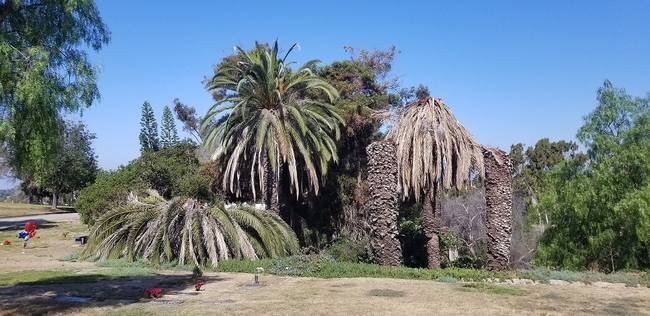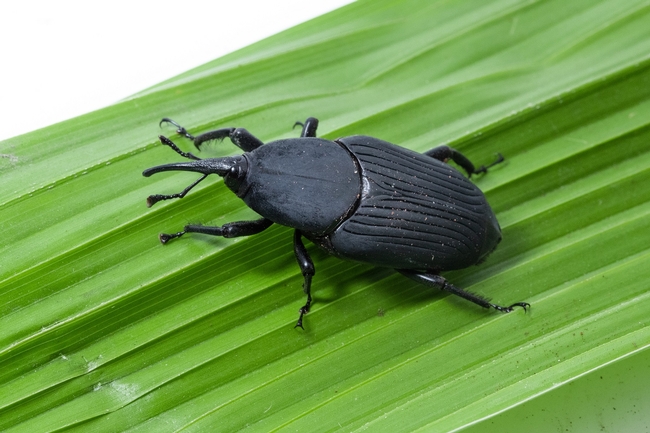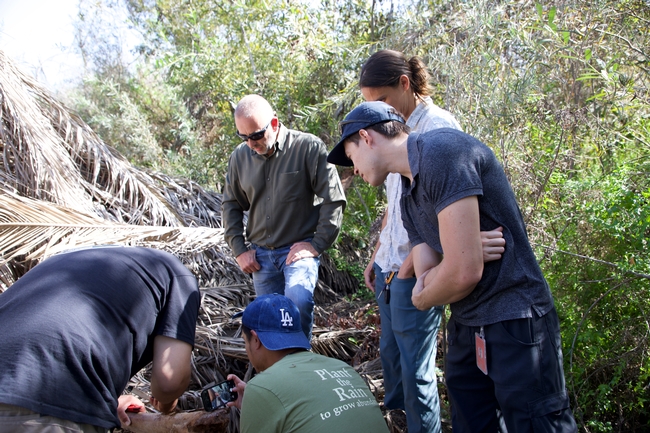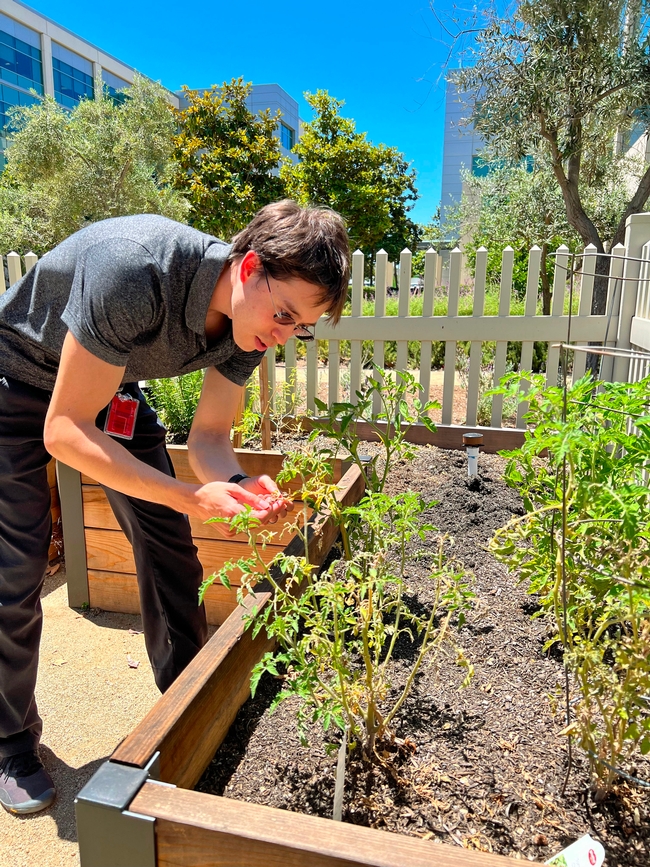Posts Tagged: Middleton
Palm weevil threatens So Cal palm trees
More than 20,000 palms in the region have been killed by South American palm weevil
The swaying palm trees that line San Diego's streets might not be swaying much longer due to a pest that is infecting many of these iconic trees and making its way across Southern California.
The South American palm weevil (SAPW), also referred to as the American palm weevil and black palm weevil, was first detected in San Diego County in 2011, with breeding populations found in a Canary Island date palm in San Ysidro in 2015. According to industry experts, more than 20,000 palms in the region have been killed by SAPW thus far.
While SAPW can attack a variety of palm tree species, Canary Island date palms (Phoenix canariensis) are by far their most preferred host. SAPW adults lay their eggs in the crown of palm trees and then larvae hatch and voraciously consume the growing tissue of the palm. If left unchecked, this pest can kill mature palms in a matter of months.
SAPW has affected neighborhoods and cities throughout the greater San Diego area, creating a need for more residents to be aware of this concern and report infected palms. Though infestation has not been confirmed, SAPW adults have been reported in the Coachella Valley – about 120 miles northeast of San Diego.
‘Super-dispersers' from San Diego can fly long distances
The California Department of Food and Agriculture has trapped weevils in the Coachella Valley and recent posts on iNaturalist, a social network for community members to map and share observations of biodiversity across the globe, indicate that adult weevils are flying into areas where edible dates are grown.
These reports interest researchers like Mark Hoddle, University of California Cooperative Extension based at UC Riverside, because the Coachella Valley, the major production area for edible dates nationwide, is far from any known infested palm trees.
How did the weevils get there? “It may be super-dispersers from San Diego,” said Hoddle. “They are on a death mission when they fly long distances – find food or die trying!”
While conducting an experiment to assess SAPW's flight capability, Hoddle and his team learned that the beetle could fly non-stop for up to five hours, with some variation between males and females. “In some cases, they will fly until they die,” Hoddle said.
Currently, Hoddle is managing an ongoing urban palm surveillance effort of 521 palm trees in and around Bonita in San Diego County, which are assessed every six months. More than 70% of these palms have been killed by SAPW over a 6.5-year period.
Although Canary Island date palms are highly preferred by SAPW, the weevils can complete their entire life cycle in sugarcane as well. For palm species that are not currently preferred by the pest, there is still a chance that they can become more preferred over time as SAPW works its way through all available Canary Island date palms in the region.
Taking action to protect your palms
There are steps that one can take to protect palm trees. Traps can be used to both monitor weevils and reduce the number of adults flying around. There are two types of traps that Hoddle has evaluated for weevil captures: the bucket trap and the Picusan trap. Both use a fermenting bait – prepared with dates, baker's yeast and water – that is placed in a glass jar with a perforated lid, in addition to a commercially available aggregation pheromone that will attract male and female weevils.
Of the two trap types, Hoddle prefers Picusan traps because they catch about six times as many weevils as bucket traps – retaining more than 95% of the weevils that are attracted to them. Bucket traps, on the other hand, retain only about 30% of weevils.
Hoddle emphasizes that trap placement is key. The Picusan trap is designed to be placed on the ground, whereas the bucket trap is typically hung from a tree branch, fence or post. Furthermore, the traps should be placed at least 500 yards away from the potential host palms and avoid direct sunlight. Shaded or partially shaded areas are best to avoid diminishing the trap's potency.
Another strategy is to prune palm trees when SAPW flight activity is low (December through March) to minimize attracting flying adult weevils to freshly pruned palms.
Finally, the best way to protect your tree is to apply insecticides. These chemicals will kill adult weevils that attempt to start infestations. While contact insecticides can deter and kill adults when applied to the crown of the palm, systemic insecticides are usually more effective and can be applied as soil and crown drenches, trunk sprays, or soil and trunk injections. Systemic insecticides move inside the palm and concentrate in the palm heart, the growing area at the top of the palm where weevils feed. Once this growing area is damaged by feeding weevil larvae, palms die.
“Just know that if you are planning to protect palms with insecticides, you are in it for life,” saidHoddle, emphasizing that there is no “one and done” approach to saving palms affected bySAPW. “Don't start if you can't commit.
Aesthetics aren't the only motivation to prevent palm infection and death caused by SAPW. Palm crowns that are highly damaged by larval feeding can detach from the top of the trunk and fall to the ground, putting people and property at risk. Dead fronds drop from dying palms and the large spines at the base of the fronds are a significant hazard to people and pets.
Seek expert support for tree concerns and removal
Removing dead palms is an expensive and time-consuming process. Removal can cost between $2,400 to $4,000 per palm, with cost varying based on location. For example, if a palm is in an area that requires the use of a crane, semitruck or helicopter to safely access, remove and dispose of the dead palm, tree removal can cost up to $15,000.
Once a palm is infested with SAPW, it likely cannot be saved unless it is aggressively treated with insecticides at an early stage of the infestation. If you are certain that a tree is infected by SAPW, it is highly recommended that you work with a tree care company or arborist to manage the weevils that might be present in the palm and to promptly and responsibly dispose of dead palms so that spread of weevils into new areas is minimized.
To confirm visual signs of palm trees that have been affected by SAPW, visit Hoddle's site for more information and to report infested palms: https://cisr.ucr.edu/invasive-species/palmarum-survey.
To read this story in Spanish, visit: https://ucanr.edu/blogs/blogcore/postdetail.cfm?postnum=58381
‘Bug Ninja’ migrates to SoCal to help growers conquer insects
Middleton describes himself as a “full-time entomologist and part-time ninja warrior.” When he is not training for ANW, Middleton works as an integrated pest management (IPM) advisor for University of California Cooperative Extension in San Diego County.
“Broadly, I like to think of IPM as increasing your knowledge and diversifying your tools so that you rely on pesticides a lot less for conventional agricultural practices,” he explained.
Middleton's own background is anything but conventional. His popularity on the hit TV show can largely be attributed to his unique culinary tastes in insects. During season 10 of ANW, Middleton struck a deal with the show announcers, Matt Iseman and Akbar Gbaja-Biamila, claiming that if he completed the obstacle course, the pair would have to eat an insect of his choosing.
Spoiler alert: Iseman and Gbaja-Biamila did have to eat tempura-fried tarantula and scorpion thanks to Middleton, who says that he has also tried the two delicacies.
A part of his backstory on ANW includes b-roll of Middleton prepping and eating his favorite – a tempura-fried tarantula. During his on-camera interview, he explained that insects offer nutritional value and can be a viable source of protein when countering climate change's effect on food sources.
Studying bugs and becoming an entomologist was not a career path Middleton always had in mind. Rather, it was a realization that became more apparent the more time he spent with his mother.
“I grew up in Utah. My mom is a geologist, and I spent a lot of time with her out in the field,” he said. “She was always looking at rocks. Rocks aren't the most interesting to me so I would find things more interesting to look at, like bugs.”
It was not until he began college that Middleton decided he would become an entomologist. “I really wanted to learn more about the natural world, and insects are a good way to do that because they're so involved in natural processes and ecosystems,” he explained.
Middleton earned a B.S. in biology from the University of Utah and a Ph.D. from the University of Minnesota-Twin Cities.
One of Middleton's fondest memories while attending the University of Minnesota is when he designed and taught an undergraduate course on insect warriors. Middleton wanted a course that would “engage undergrads in a way that would get them interested in entomology.”
Leveraging his stardom from ANW, Middleton based the course on how insects were used in warfare. Students who took the course were intrigued and genuinely wanted to learn why insects make such formidable warriors or athletes.
While working as a postdoctoral fellow at the University of Florida's Citrus Research and Education Center in Lake Alfred, Middleton focused on developing management options for the Lebbeck mealybug in Florida citrus.
Now that he has relocated to San Diego, Middleton expressed excitement for the diversity that comes with living in southern California, which includes working with citrus, floriculture, avocado growers, small farms, or all the above.
“What's really interesting about working with UC ANR is the fact that you could work with almost anything you want,” he explained. “It also provides a great opportunity to do research that's applicable and impactful to a diverse group of people.”
One of the challenges that Middleton is already mindful of is prioritizing needs. Floriculture and nurseries, for example, face many challenges. Given that they are two of the biggest industries in the area, focusing on them alone can lead to other aspects becoming more neglected.
When asked how he plans to address the challenges ahead, Middleton said that it all comes down to intentionality and, ideally, conducting research that becomes standard practice. One of Middleton's goals is to essentially identify pest management practices that are beneficial for the environment.
“It's broad, but I'd really like to make regenerative agriculture, ways of producing food or other commodities, more sustainable,” he said.
Meanwhile, he continues to build momentum for his work from his participation in ANW – using the platform to challenge people's perspectives about the natural world and applying his ninja skills to overcome obstacles that California growers face.
If you cannot find Middleton in the office or field, try tuning into the latest season of ANW. His results are still under wraps, but the nation will find out just how determined the “Bug Ninja” is soon enough.
Middleton is based out of the UCCE office in San Diego and can be reached at egmiddleton@ucanr.edu.






